Mechanical and Microstructure Properties of Biochar-Based Mortar: An Internal Curing Agent for PCC
Abstract
:1. Introduction
1.1. Literature Review/Background
1.1.1. Production Process and Physicochemical Properties of Biochar
1.1.2. Internal Curing in Cementitious Composites
1.2. Research Objectives and Scope of Work
2. Materials and Methods
2.1. Constituent Materials
2.2. Water Absorption and Desorption Behavior of Biochar
2.3. Mineralogical Composition, Morphology, and Elemental Composition of Biochar
2.4. Mortar Mix Design and Fabrication
- Sealed conditions: Samples were sealed under vacuum, in puncture-resistant polymer bags to experience internal drying only (Figure 7d). The sealed system prevents loss or gain of moisture present in the surrounding environment and thus increases the hydration reactions with the existing mixing water content [16];
- Unsealed conditions: Samples were exposed to room temperature and constant relative humidity of 76% and allowed to undergo both internal and external drying (Figure 7b).
2.5. Compressive Strength
2.6. Interfacial Transition Zone (ITZ) Using SEM
3. Results and Discussion
3.1. Compressive Strength
3.1.1. Effect of Biochar Replacement on the Compressive Strength of Mortar Cubes
3.1.2. Effect of Internal Curing on the Compressive Strength of Mortar Cubes
- Increase in strength with increasing number of days for all mixes and curing conditions, which is expected;
- Compressive strength decreases slightly with increase of biochar content up to 10%. After that, the drop becomes significant;
- Compressive strength loss between control mortar and mortar with biochar is more significant for water cured samples;
- The development and values of compressive strength for 5% and 10% biochar replacement are almost identical, suggesting an acceptable upper limit of 10% biochar. The strength drops significantly after that, as witnessed for 15% biochar replacement samples.
3.2. Interfacial Transition Zone (ITZ)
4. Conclusions
- Biochar consists of interconnected fibers, forming a microporous cellular structure that can absorb and sustain a substantial amount of water to be used for internal curing. However, further studies on the effect of w/c ratio and the degree of saturation of biochar particles, prior to their inclusion in the mortar, is necessary to determine the optimum mix design that would yield a satisfactory mechanical and durable performance;
- The inclusion of partially saturated biochar in cementitious mortar composites generally decreases the compressive strength for various curing conditions. It is suggested that the biochar replacement of sand be limited to 15% and be fully saturated prior to inclusion in mortar for better results;
- It was found that the ITZ of biochar particles is superior to that of sand particles, due to the interlocking mechanisms exhibited by the pores at the face of the particles, which is caused by the water migrating from the internal reservoirs of the biochar to the surrounding paste. This migration promotes hydration reactions and results in a denser, less porous ITZ. However, quantitative analysis that quantifies the porosity, surface energy, and micro hardness of the interfacial transition zone at the biochar–cement paste interface should be carried out;
- Conducting further research to better understand and predict the effect of biochar inclusion on the durability of the mortars, including shrinkage deformation, is recommended.
Author Contributions
Funding
Conflicts of Interest
References
- Balasubramanian, J.; Gopal, E.; Periakaruppan, P. Strength and microstructure of mortar with sand substitutes. Građevinar 2016, 68, 29–37. [Google Scholar]
- Manasseh, J. Use of crushed granite fine as replacement to river sand in concrete production. Leonardo Electron. J. Pract. Technol. 2010, 17, 85–96. [Google Scholar]
- Modolo, R.; Ferreira, V.M.; Tarelho, L.A.; Labrincha, J.A.; Senff, L.; Silva, L. Mortar formulations with bottom ash from biomass combustion. Constr. Build. Mater. 2013, 45, 275–281. [Google Scholar] [CrossRef]
- Andrade, L.; Rocha, J.; Cheriaf, M. Influence of coal bottom ash as fine aggregate on fresh properties of concrete. Constr. Build. Mater. 2009, 23, 609–614. [Google Scholar] [CrossRef]
- Torkittikul, P.; Nochaiya, T.; Wongkeo, W.; Chaipanich, A. Utilization of coal bottom ash to improve thermal insulation of construction material. J. Mater. Cycles Waste Manag. 2017, 19, 305–317. [Google Scholar] [CrossRef]
- Bilir, T.; Gencel, O.; Topcu, I.B. Properties of mortars with fly ash as fine aggregate. Constr. Build. Mater. 2015, 93, 782–789. [Google Scholar] [CrossRef]
- Zhao, S.; Huang, B.; Shu, X.; Ye, P. Laboratory investigation of biochar-modified asphalt mixture. Transp. Res. Rec. J. Transp. Res. Board 2014, 2445, 56–63. [Google Scholar] [CrossRef]
- Malkow, T. Novel and innovative pyrolysis and gasification technologies for energy efficient and environmentally sound MSW disposal. Waste Manag. 2004, 24, 53–79. [Google Scholar] [CrossRef]
- Chen, D.; Yin, L.; Wang, H.; He, P. Reprint of: Pyrolysis technologies for municipal solid waste: A review. Waste Manag. 2015, 37, 116–136. [Google Scholar] [CrossRef]
- Onyango, D.O. Pyrolysis: An alternative technology for municipal solid waste management. In Proceedings of the 2013 JKUAT Scientific Technological and Industrialization Conference, Nairobi, Kenya, 14–15 November 2013. [Google Scholar]
- Lehmann, J.; Joseph, S. Biochar for Environmental Management: Science, Technology and Implementation; Routledge: Abingdon, UK, 2015. [Google Scholar]
- Brewer, C.E. Biochar Characterization and Engineering. Ph.D. Thesis, Iowa State University, Ames, IA, USA, 2012. [Google Scholar]
- Gupta, S.; Kua, H.W.; Low, C.Y. Use of biochar as carbon sequestering additive in cement mortar. Cem. Concr. Compos. 2018, 87, 110–129. [Google Scholar] [CrossRef]
- Ali, A.; Sarmah, K. Novel biochar-concrete composites: Manufacturing, characterization and evaluation of the mechanical properties. Sci. Total Environ. 2018, 616–617, 408–416. [Google Scholar]
- Famili, H.; Saryazdi, M.K.; Parhizkar, T. Internal curing of high strength self-consolidating concrete by saturated lightweight aggregate-effects on material properties. Int. J. Civ. Eng. 2012, 10, 210–221. [Google Scholar]
- Henkensiefken, R.; Castro, J.; Kim, H.; Bentz, D.; Weiss, J. Internal curing improves concrete performance throughout its life. Concr. InFocus 2009, 8, 22–30. [Google Scholar]
- Castro, J.; Keiser, L.; Golias, M.; Weiss, J. Absorption and desorption properties of fine lightweight aggregate for application to internally cured concrete mixtures. Cem. Concr. Compos. 2011, 33, 1001–1008. [Google Scholar] [CrossRef]
- Henkensiefken, R.; Bentz, D.; Nantung, T.; Weiss, J. Volume change and cracking in internally cured mixtures made with saturated lightweight aggregate under sealed and unsealed conditions. Cem. Concr. Compos. 2009, 31, 427–437. [Google Scholar] [CrossRef]
- Sun, X.; Zhang, B.; Dai, Q.; Yu, X. Investigation of internal curing effects on microstructure and permeability of interface transition zones in cement mortar with SEM imaging, transport simulation and hydration modeling techniques. Constr. Build. Mater. 2015, 76, 366–379. [Google Scholar] [CrossRef]
- Lura, P.; Jensen, O.M.; Igarashi, S. Experimental observation of internal water curing of concrete. Mater. Struct. 2007, 40, 211–220. [Google Scholar] [CrossRef]
- Bentz, D.P.; Stutzman, P.E. Internal Curing and Microstructure of high-Performance Mortars; ACI SP-256; Internal Curing of High-Performance Concretes: Laboratory and Field Experiences, American Concrete Institute: Farmington Hills, MI, USA, 2008; pp. 81–90. [Google Scholar]
- Al-Khaiat, H.; Haque, M.N. Effect of initial curing on early strength and physical properties of a lightweight concrete. Cem. Concr. Res. 1998, 28, 859–866. [Google Scholar] [CrossRef]
- Lam, H. Effects of Internal Curing Methods on Restrained Shrinkage and Permeability. Master’s Thesis, University of Toronto, Toronto, ON, Canada, 2005. [Google Scholar]
- Lura, P. Autogenous Deformation and Internal Curing of Concrete. 2003. Available online: http://resolver.tudelft.nl/uuid:1a1efc2d-a638-4787-b543-5bd643a39a4b (accessed on 23 March 2019).
- Wong, H.S.; Buenfeld, N.R. Euclidean distance mapping for computing microstructural gradients at interfaces in composite materials. Cem. Concr. Res. 2006, 36, 1091–1097. [Google Scholar] [CrossRef]
- Hilal, A.A. Microstructure of Concrete. High Performance Concrete Technology and Applications; InTech: Rijeka, Croatia, 2016. [Google Scholar]
- Scrivener, K.L.; Crumbie, A.K.; Laugesen, P. The interfacial transition zone (ITZ) between cement paste and aggregate in concrete. Interface Sci. 2004, 12, 411–421. [Google Scholar] [CrossRef]
- Vargas, P.; Restrepo-Baena, O.; Tobón, J.I. Microstructural analysis of interfacial transition zone (ITZ) and its impact on the compressive strength of lightweight concretes. Constr. Build. Mater. 2017, 137, 381–389. [Google Scholar] [CrossRef]
- Lura, P.; Wyrzykowski, M.; Tang, C.; Lehmann, E. Internal curing with lightweight aggregate produced from biomass-derived waste. Cem. Concr. Res. 2014, 59, 24–33. [Google Scholar] [CrossRef]
- Gupta, S.; Kua, H.W. Effect of water entrainment by pre-soaked biochar particles on strength and permeability of cement mortar. Constr. Build. Mater. 2018, 159, 107–125. [Google Scholar] [CrossRef]
- EPA. National Primary Drinking Water Regulations. Available online: https://www.gvsu.edu/cms4/asset/E1327343-09F0-03FF-AA9032F47AD1EB9C/standards.pdf (accessed on 23 March 2019).
- Bentz, D.P. Internal curing of high-performance blended cement mortars. ACI Mater. J. 2007, 104, 408. [Google Scholar]
- Bentz, D.P. Influence of internal curing using lightweight aggregates on interfacial transition zone percolation and chloride ingress in mortars. Cem. Concr. Compos. 2009, 31, 285–289. [Google Scholar] [CrossRef]
- Lo, Y.; Gao, X.F.; Jeary, A.P. Microstructure of pre-wetted aggregate on lightweight concrete. Build. Environ. 1999, 34, 759–764. [Google Scholar] [CrossRef]
- Zhang, M.H.; Gjørv, O.E. Microstructure of the interfacial zone between lightweight aggregate and cement paste. Cem. Concr. Res. 1990, 20, 610–618. [Google Scholar] [CrossRef]
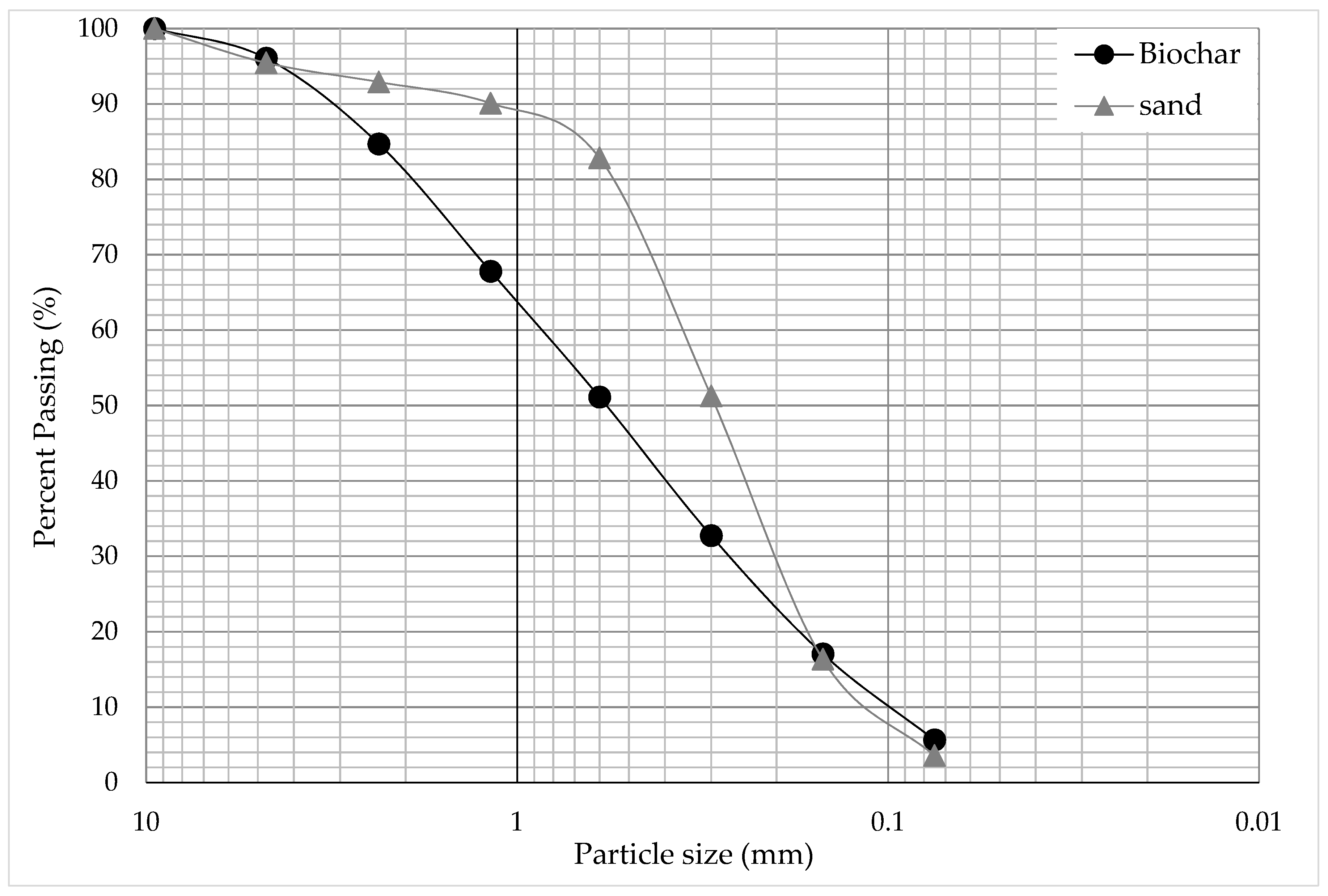
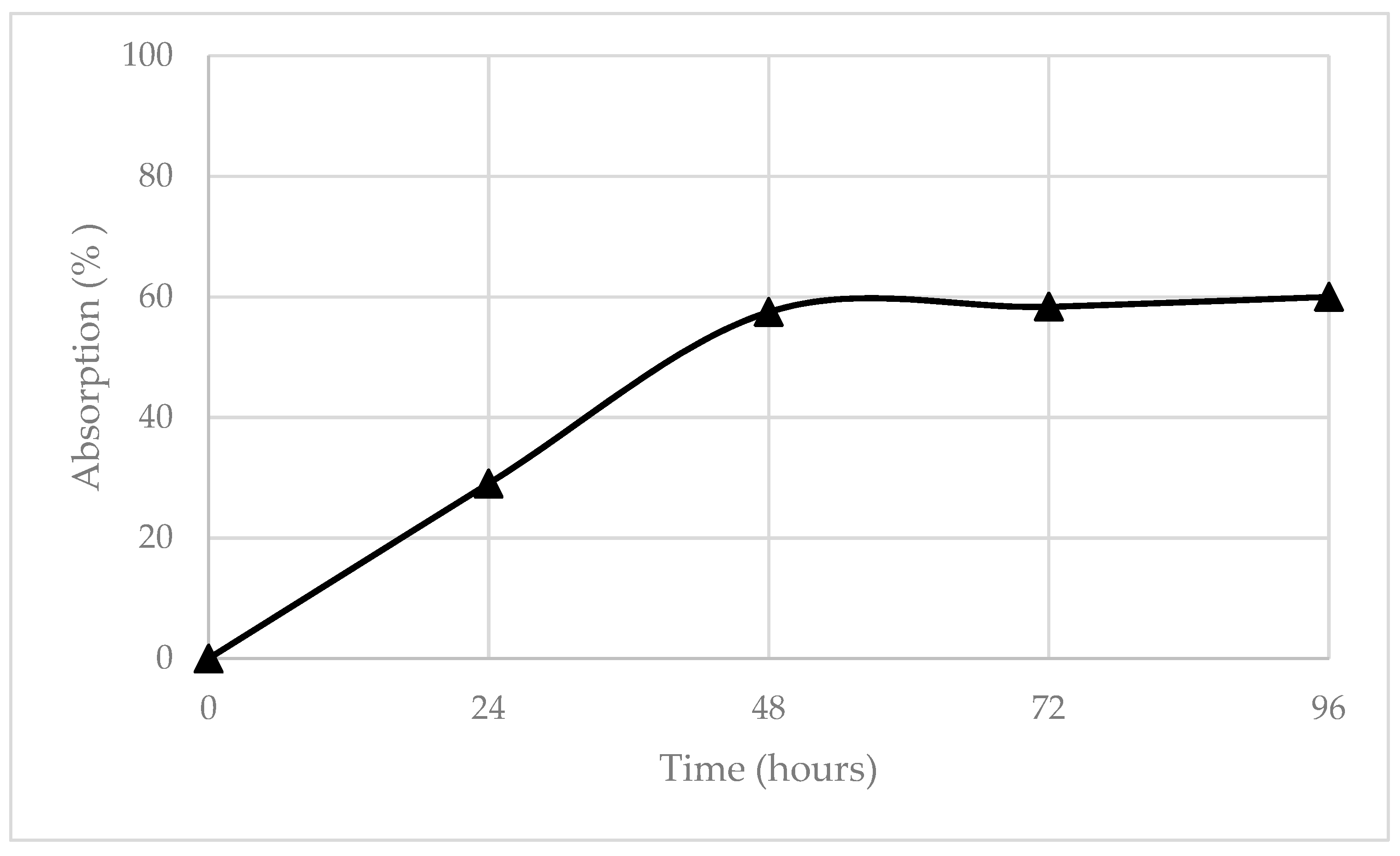
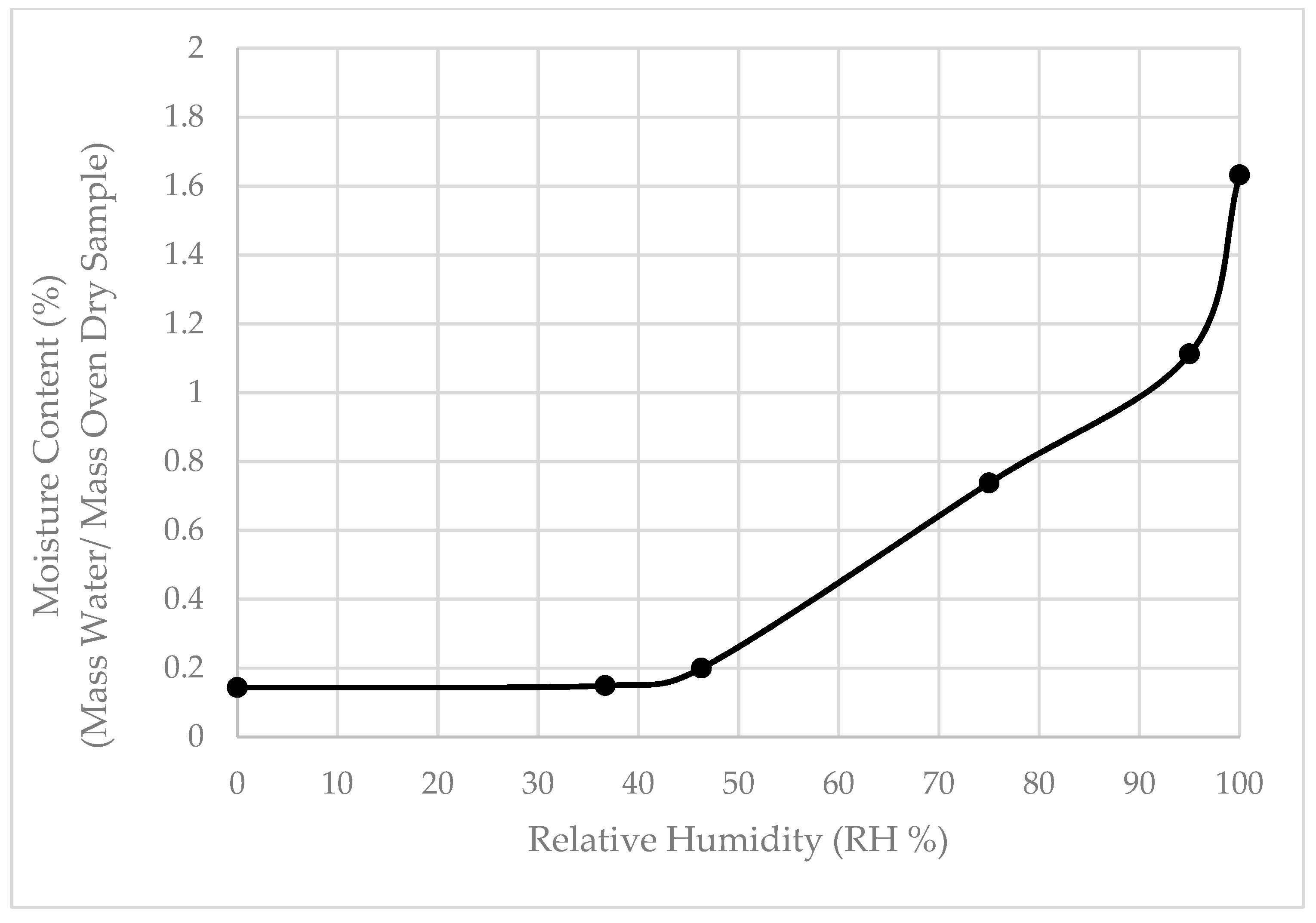

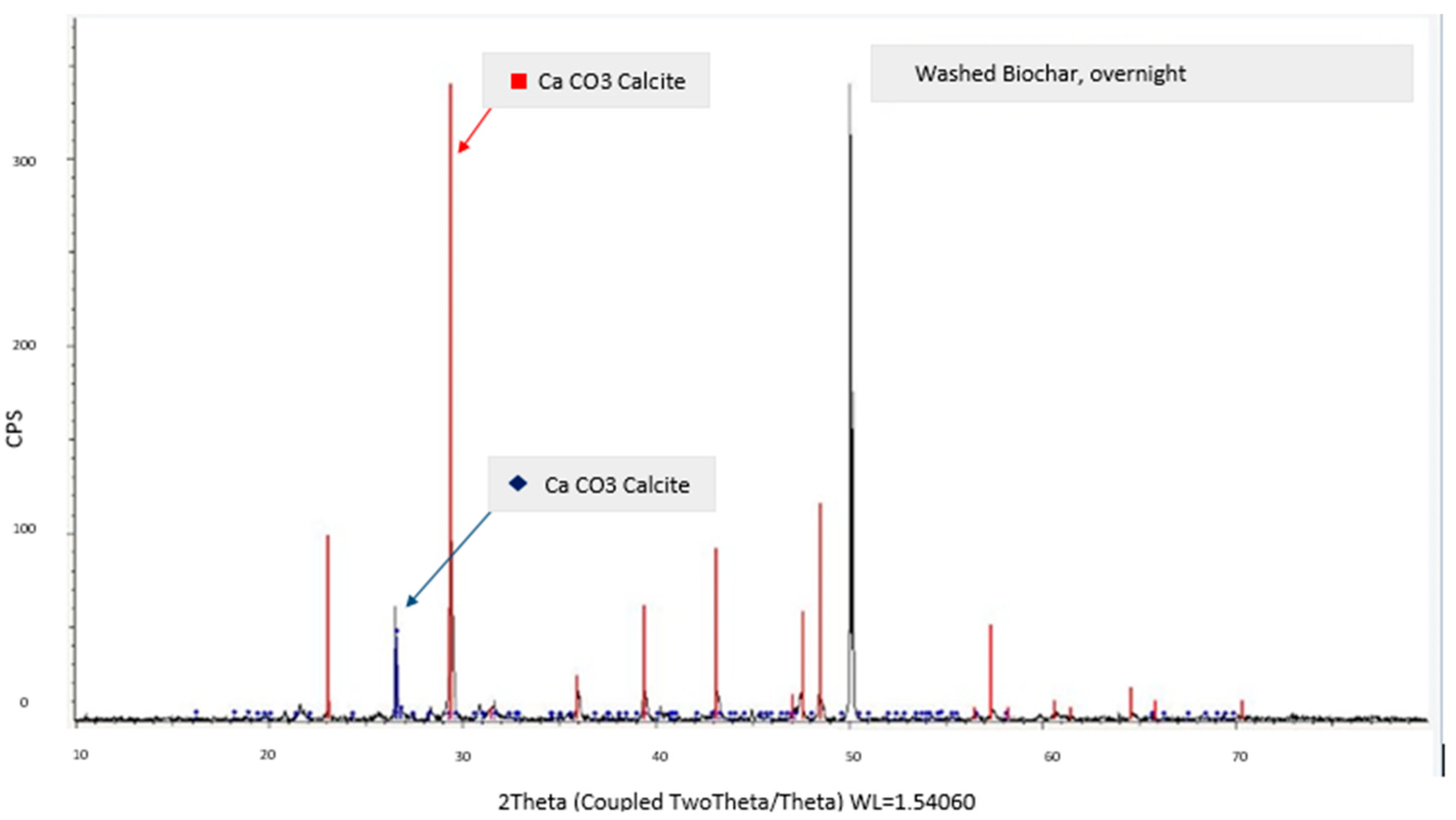
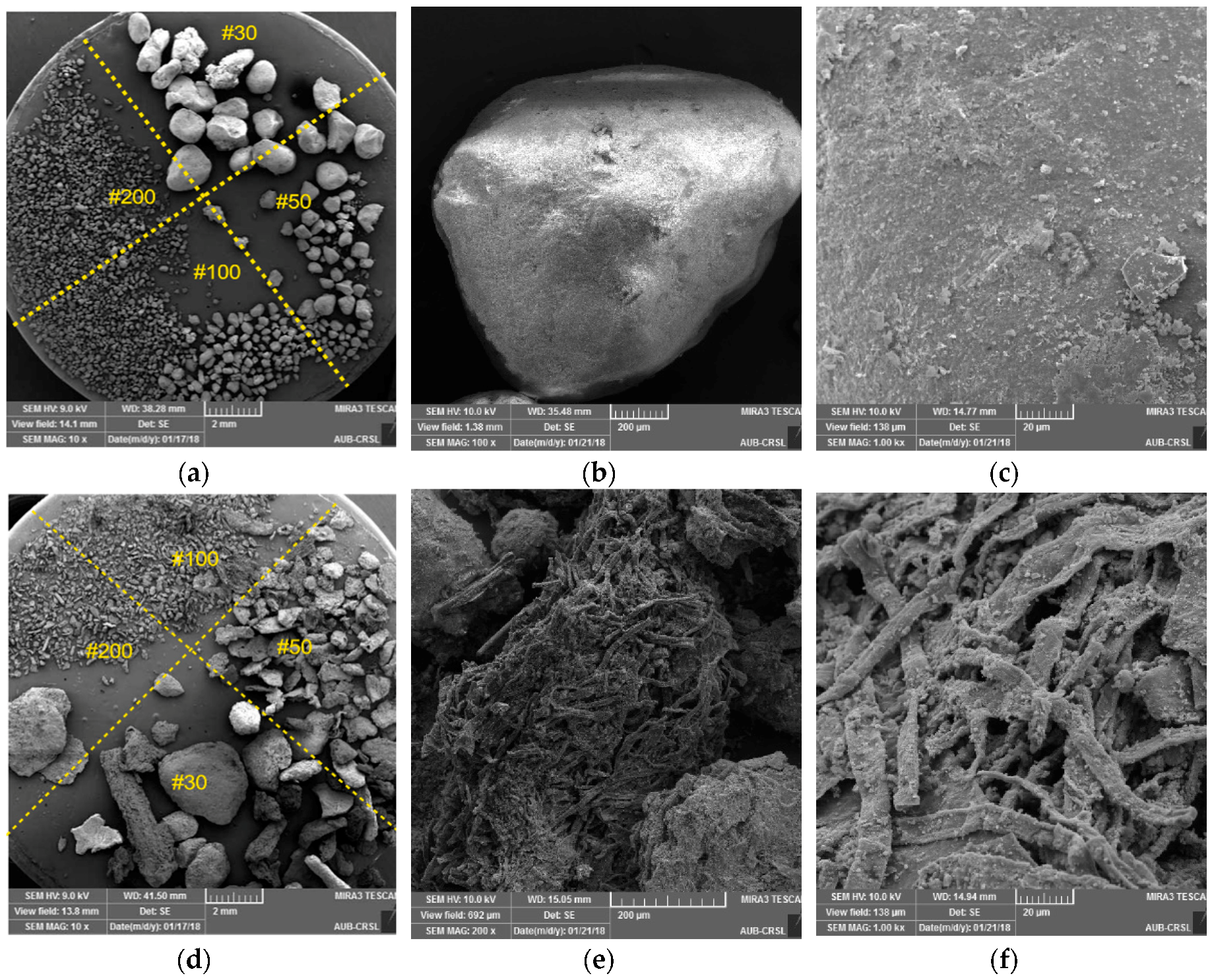
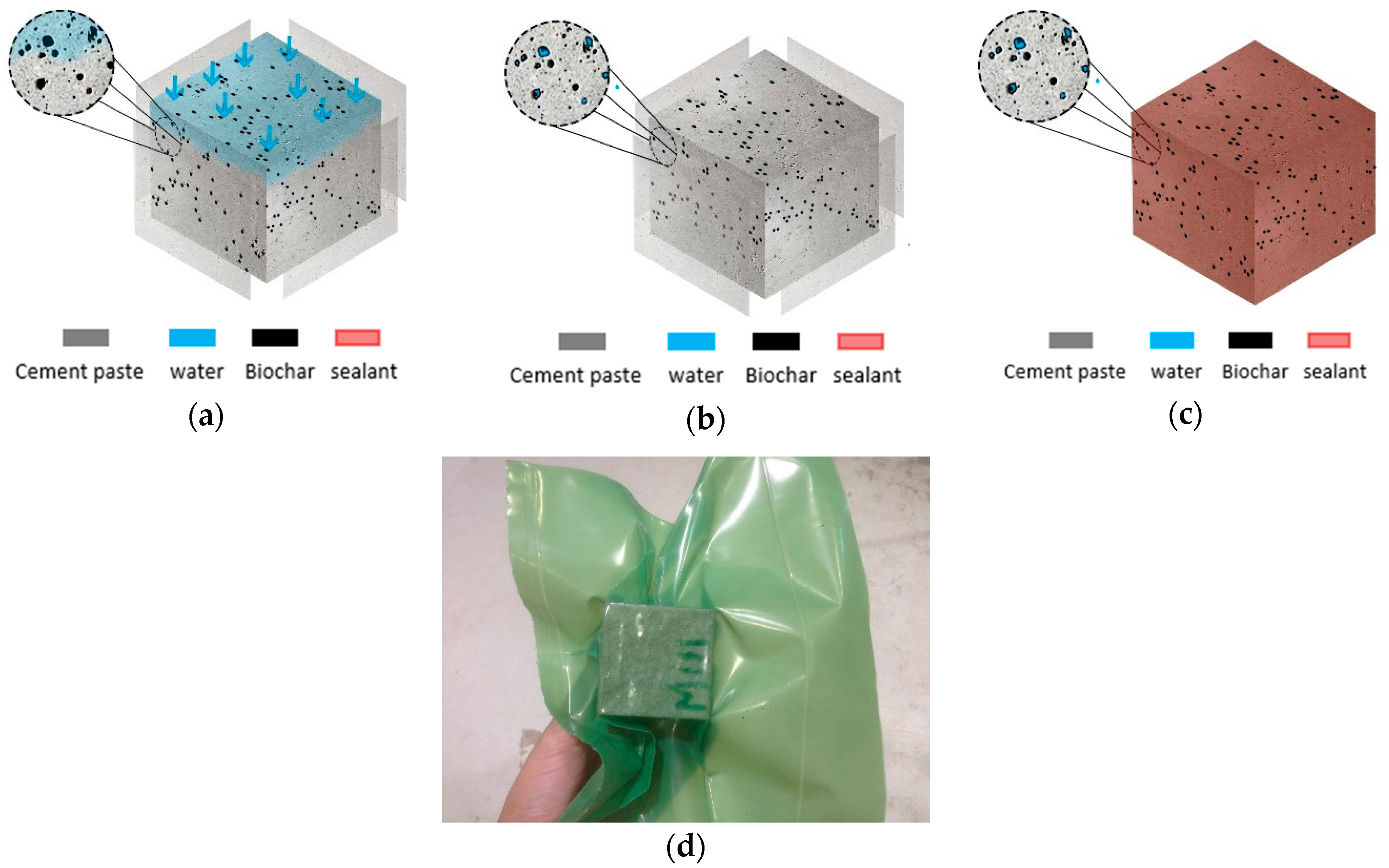


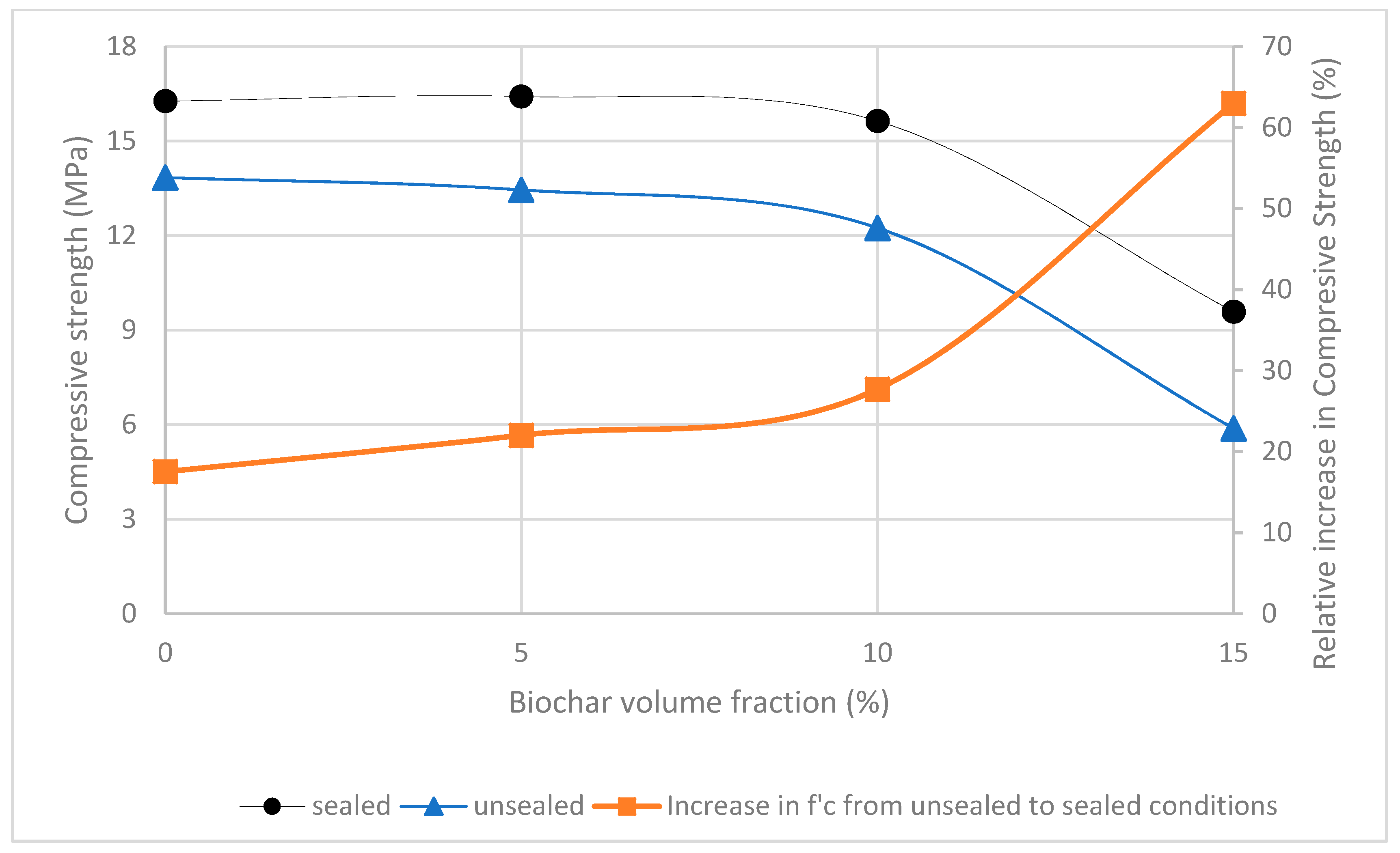
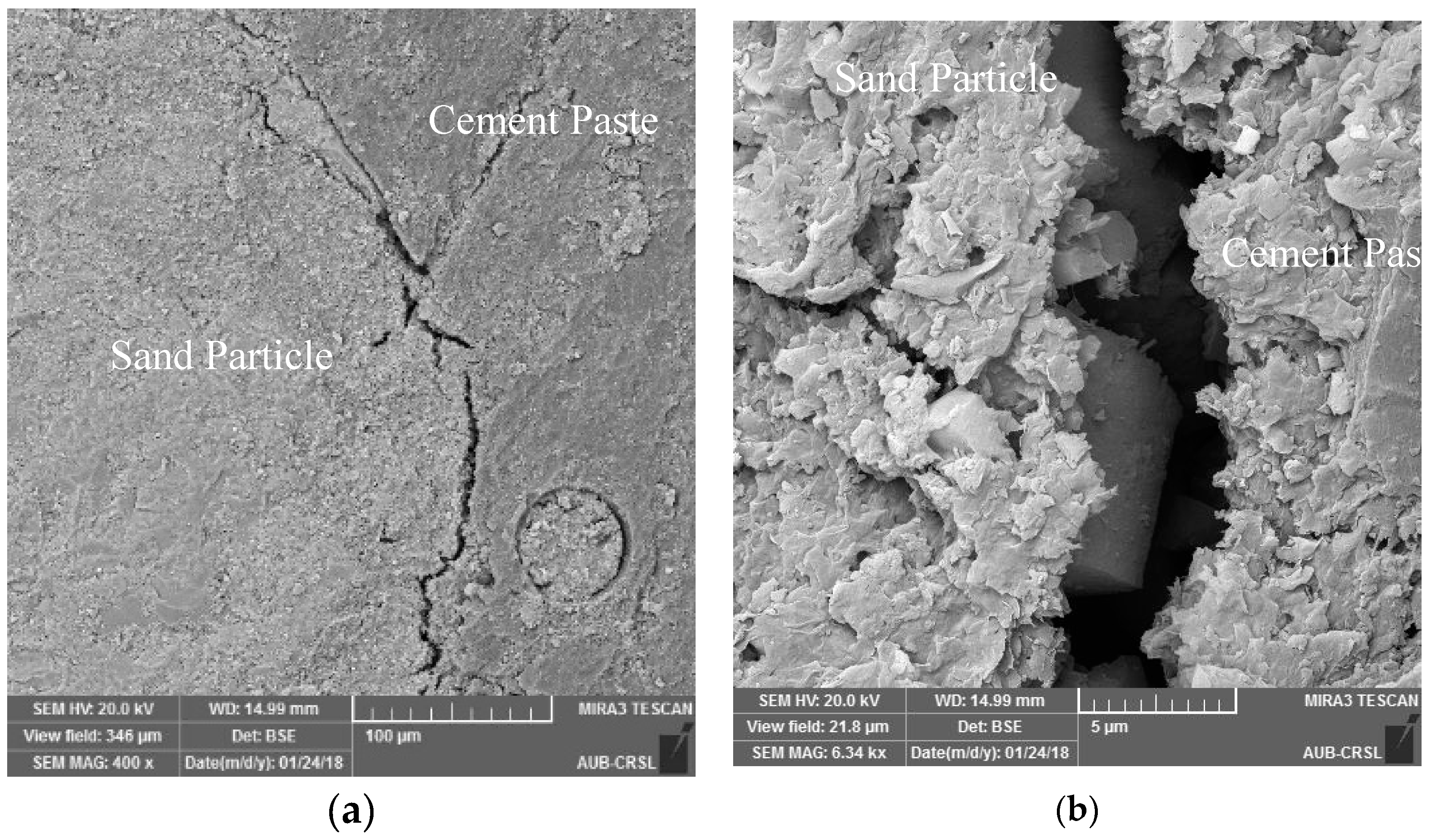
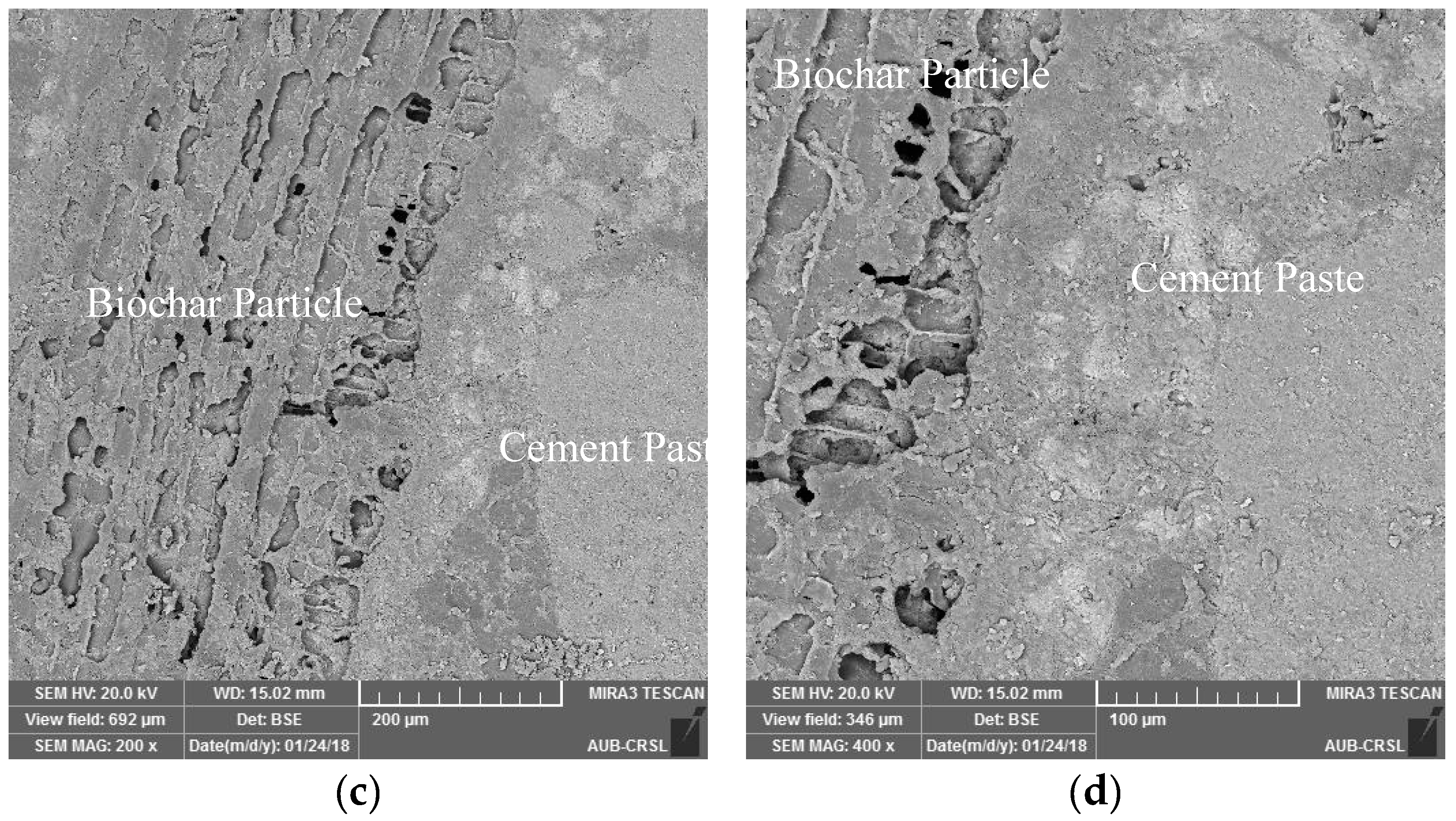

| Mix Id | Biochar (%) | Cement (g) | Sand (g) | Biochar (g) | W/C | Curing Conditions |
|---|---|---|---|---|---|---|
| M0 | 0.0 | 271.0 | 792.0 | 0.0 | 0.43 | Air and Water Cured |
| M1 | 5.0 | 271.0 | 752.4 | 39.6 | 0.43 | Air Cured Only |
| M2 | 10.0 | 271.0 | 712.8 | 79.2 | 0.43 | Air and Water Cured |
| M3 | 15.0 | 271.0 | 673.2 | 118.8 | 0.43 | Air Cured Only |
| M4 | 25.0 | 271.0 | 594.0 | 198.0 | 0.43 | Air and Water Cured |
| M5 | 45.0 | 271.0 | 435.6 | 356.4 | 0.43 | Air and Water Cured |
© 2019 by the authors. Licensee MDPI, Basel, Switzerland. This article is an open access article distributed under the terms and conditions of the Creative Commons Attribution (CC BY) license (http://creativecommons.org/licenses/by/4.0/).
Share and Cite
Mrad, R.; Chehab, G. Mechanical and Microstructure Properties of Biochar-Based Mortar: An Internal Curing Agent for PCC. Sustainability 2019, 11, 2491. https://doi.org/10.3390/su11092491
Mrad R, Chehab G. Mechanical and Microstructure Properties of Biochar-Based Mortar: An Internal Curing Agent for PCC. Sustainability. 2019; 11(9):2491. https://doi.org/10.3390/su11092491
Chicago/Turabian StyleMrad, Rayane, and Ghassan Chehab. 2019. "Mechanical and Microstructure Properties of Biochar-Based Mortar: An Internal Curing Agent for PCC" Sustainability 11, no. 9: 2491. https://doi.org/10.3390/su11092491
APA StyleMrad, R., & Chehab, G. (2019). Mechanical and Microstructure Properties of Biochar-Based Mortar: An Internal Curing Agent for PCC. Sustainability, 11(9), 2491. https://doi.org/10.3390/su11092491





